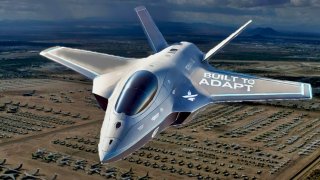NGAD Fighter Costs Could Mean The Time Has Come for 'Light Fighter'
The United States and the United Kingdom continue to invest heavily in advanced military technologies, such as the sixth-generation warplane programs NGAD and FCAS. But Light Fighter could take their place.
Summary and Key Points: The United States and the United Kingdom continue to invest heavily in advanced military technologies, such as the sixth-generation warplane programs NGAD and FCAS.
However, the staggering costs and practical challenges of these "wonder weapons" have led to growing concerns about their viability.
U.S. Air Force leaders are now considering a more adaptable and affordable approach, possibly introducing a "Light Fighter" concept.
NGAD: U.S. Air Force Reassesses Costly Sixth-Gen Warplane Plans
As Western defense industries face budget constraints and inefficiencies, there is a pressing need to focus on more practical, cost-effective systems that address immediate threats rather than long-term, high-cost projects.
The United States and its Western allies, notably the United Kingdom, remain deeply ensconced in the cult of the wonder weapon. Western militaries will splurge on highly complex systems that promise to do it all but are so expensive they rarely deliver what they advertise.
As the West enters what can only be described as a protracted debt crisis, even the insulated defense chiefs of Washington and London are starting to realize they may have run up against the law of diminishing returns.
The System of Systems and Light Fighter
A recent meeting of British and American defense chiefs at the UK Air and Space Power Association in late July shows Western leaders running up against the limits of what their governments can do in terms of funding the two countries’ sixth-generation warplane programs.
In the United States, the Pentagon refers to their program as the lofty sounding Next Generation Air Dominance, or NGAD. It is billed as a family of systems, and the Brits have something similar known as the Future Combat Air System.
The costs are obscene. The American sixth-generation bird is going to cost an astonishing $300 million per plane, and the Pentagon wants hundreds of them. Each of the manned sixth-generation warplanes will be augmented by a fleet of next-generation drones, as well as the most advanced artificial intelligence capabilities, cloud computing, and other next-generation technologies.
Again, the problem is cost and practicality. One can put anything down on paper. Bringing it to life is quite a different matter.
To overcome practicality and cost concerns, U.S. Air Force Chief of Staff Gen. David Allvin, along with other defense leaders involved in the NGAD program, admitted that they were kicking around the concept of a sixth-generation “Light Fighter.”
According to The Aviationist, U.S. officials at the UK’s Global Air and Space Chiefs’ Conference in July were “hoping for more ‘adaptable’ platforms that can be easily modified and upgraded.” Describing their new idea as a “notional” concept, Air Force leadership spoke about the need to move away from the “built to last philosophy to [the] built to adapt” model.
Affordability and other constraints on the defense-industrial base are forcing the Air Force to reassess its procurement model for new warplanes – however slowly that reassessment is happening.
Just a few weeks ago, the Air Force did place their sixth-generation warplane acquisition plans on hold as they sought out a contractor who could meet the frankly insane requirements of these obscenely expensive experimental warplanes.
What Decadence
In today’s age, what’s needed is less a warplane that can do it all – and remain in service for decades – and more a system relevant to the threat environment of the next 10-15 years.
Given the crisis in Western defense-industrial capabilities, the preference for more complex, expensive systems is misplaced. America needs cheaper, more adaptable, and disposable systems. Ditto for the British, whose defense industry is an even messier swamp of inefficiency, corruption, and decadence.
Author Experience and Expertise: Brandon J. Weichert
Brandon J. Weichert, a National Interest national security analyst, is a former Congressional staffer and geopolitical analyst who is a contributor at The Washington Times, the Asia Times, and The-Pipeline. He is the author of Winning Space: How America Remains a Superpower, Biohacked: China’s Race to Control Life, and The Shadow War: Iran’s Quest for Supremacy. His next book, A Disaster of Our Own Making: How the West Lost Ukraine, is due October 22 from Encounter Books. Weichert can be followed via Twitter @WeTheBrandon.
All images are Creative Commons or Shutterstock.
From the Vault
Russia Freaked Out: Why the U.S. Navy 'Unretired' the Iowa-Class Battleships
Battleship vs. Battlecruiser: Iowa-Class vs. Russia's Kirov-Class (Who Wins?)


